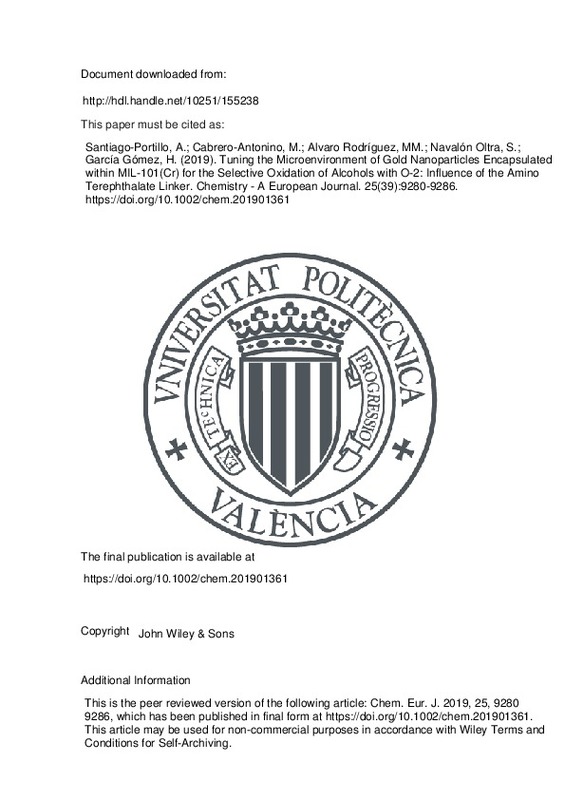H�ft, E., Kosslick, H., Fricke, R., & Hamann, H.-J. (1996). Titanhaltige Molekularsiebe als Katalysatoren f�r selektive Oxidationsreaktionen mit Wasserstoffperoxid. Journal f�r Praktische Chemie/Chemiker-Zeitung, 338(1), 1-15. doi:10.1002/prac.19963380102
Matsumoto, T., Ueno, M., Wang, N., & Kobayashi, S. (2008). Recent Advances in Immobilized Metal Catalysts for Environmentally Benign Oxidation of Alcohols. Chemistry - An Asian Journal, 3(2), 196-214. doi:10.1002/asia.200700359
Saikia, M., Bhuyan, D., & Saikia, L. (2015). Facile synthesis of Fe3O4nanoparticles on metal organic framework MIL-101(Cr): characterization and catalytic activity. New Journal of Chemistry, 39(1), 64-67. doi:10.1039/c4nj01312c
[+]
H�ft, E., Kosslick, H., Fricke, R., & Hamann, H.-J. (1996). Titanhaltige Molekularsiebe als Katalysatoren f�r selektive Oxidationsreaktionen mit Wasserstoffperoxid. Journal f�r Praktische Chemie/Chemiker-Zeitung, 338(1), 1-15. doi:10.1002/prac.19963380102
Matsumoto, T., Ueno, M., Wang, N., & Kobayashi, S. (2008). Recent Advances in Immobilized Metal Catalysts for Environmentally Benign Oxidation of Alcohols. Chemistry - An Asian Journal, 3(2), 196-214. doi:10.1002/asia.200700359
Saikia, M., Bhuyan, D., & Saikia, L. (2015). Facile synthesis of Fe3O4nanoparticles on metal organic framework MIL-101(Cr): characterization and catalytic activity. New Journal of Chemistry, 39(1), 64-67. doi:10.1039/c4nj01312c
Corma, A., & Garcia, H. (2008). Supported gold nanoparticles as catalysts for organic reactions. Chemical Society Reviews, 37(9), 2096. doi:10.1039/b707314n
Parmeggiani, C., & Cardona, F. (2012). Transition metal based catalysts in the aerobic oxidation of alcohols. Green Chemistry, 14(3), 547. doi:10.1039/c2gc16344f
Stahl, S. S. (2004). Palladium Oxidase Catalysis: Selective Oxidation of Organic Chemicals by Direct Dioxygen-Coupled Turnover. Angewandte Chemie International Edition, 43(26), 3400-3420. doi:10.1002/anie.200300630
Dhakshinamoorthy, A., & Garcia, H. (2012). Catalysis by metal nanoparticles embedded on metal–organic frameworks. Chemical Society Reviews, 41(15), 5262. doi:10.1039/c2cs35047e
Alhumaimess, M., Lin, Z., He, Q., Lu, L., Dimitratos, N., Dummer, N. F., … Hutchings, G. J. (2014). Oxidation of Benzyl Alcohol and Carbon Monoxide Using Gold Nanoparticles Supported on MnO2Nanowire Microspheres. Chemistry - A European Journal, 20(6), 1701-1710. doi:10.1002/chem.201303355
Buonerba, A., Cuomo, C., Ortega Sánchez, S., Canton, P., & Grassi, A. (2011). Gold Nanoparticles Incarcerated in Nanoporous Syndiotactic Polystyrene Matrices as New and Efficient Catalysts for Alcohol Oxidations. Chemistry - A European Journal, 18(2), 709-715. doi:10.1002/chem.201101034
Costa, V. V., Estrada, M., Demidova, Y., Prosvirin, I., Kriventsov, V., Cotta, R. F., … Gusevskaya, E. V. (2012). Gold nanoparticles supported on magnesium oxide as catalysts for the aerobic oxidation of alcohols under alkali-free conditions. Journal of Catalysis, 292, 148-156. doi:10.1016/j.jcat.2012.05.009
Zhang, W., Xiao, Z., Wang, J., Fu, W., Tan, R., & Yin, D. (2019). Selective Aerobic Oxidation of Alcohols over Gold‐Palladium Alloy Catalysts Using Air at Atmospheric Pressure in Water. ChemCatChem, 11(6), 1779-1788. doi:10.1002/cctc.201900015
Liu, X. Y., Wang, A., Zhang, T., & Mou, C.-Y. (2013). Catalysis by gold: New insights into the support effect. Nano Today, 8(4), 403-416. doi:10.1016/j.nantod.2013.07.005
Navalon, S., Dhakshinamoorthy, A., Alvaro, M., & Garcia, H. (2016). Metal nanoparticles supported on two-dimensional graphenes as heterogeneous catalysts. Coordination Chemistry Reviews, 312, 99-148. doi:10.1016/j.ccr.2015.12.005
Dhakshinamoorthy, A., Asiri, A. M., & Garcia, H. (2017). Metal Organic Frameworks as Versatile Hosts of Au Nanoparticles in Heterogeneous Catalysis. ACS Catalysis, 7(4), 2896-2919. doi:10.1021/acscatal.6b03386
Howarth, A. J., Liu, Y., Li, P., Li, Z., Wang, T. C., Hupp, J. T., & Farha, O. K. (2016). Chemical, thermal and mechanical stabilities of metal–organic frameworks. Nature Reviews Materials, 1(3). doi:10.1038/natrevmats.2015.18
Lee, J., Farha, O. K., Roberts, J., Scheidt, K. A., Nguyen, S. T., & Hupp, J. T. (2009). Metal–organic framework materials as catalysts. Chemical Society Reviews, 38(5), 1450. doi:10.1039/b807080f
Leus, K., Concepcion, P., Vandichel, M., Meledina, M., Grirrane, A., Esquivel, D., … Van Der Voort, P. (2015). Au@UiO-66: a base free oxidation catalyst. RSC Advances, 5(29), 22334-22342. doi:10.1039/c4ra16800c
Saikia, M., Kaichev, V., & Saikia, L. (2016). Gold nanoparticles supported on nanoscale amine-functionalized MIL-101(Cr) as a highly active catalyst for epoxidation of styrene. RSC Advances, 6(108), 106856-106865. doi:10.1039/c6ra24458k
Liu, H., Liu, Y., Li, Y., Tang, Z., & Jiang, H. (2010). Metal−Organic Framework Supported Gold Nanoparticles as a Highly Active Heterogeneous Catalyst for Aerobic Oxidation of Alcohols. The Journal of Physical Chemistry C, 114(31), 13362-13369. doi:10.1021/jp105666f
Lammert, M., Bernt, S., Vermoortele, F., De Vos, D. E., & Stock, N. (2013). Single- and Mixed-Linker Cr-MIL-101 Derivatives: A High-Throughput Investigation. Inorganic Chemistry, 52(15), 8521-8528. doi:10.1021/ic4005328
Zhu, Q.-L., Li, J., & Xu, Q. (2013). Immobilizing Metal Nanoparticles to Metal–Organic Frameworks with Size and Location Control for Optimizing Catalytic Performance. Journal of the American Chemical Society, 135(28), 10210-10213. doi:10.1021/ja403330m
Chen, Y. F., Babarao, R., Sandler, S. I., & Jiang, J. W. (2010). Metal−Organic Framework MIL-101 for Adsorption and Effect of Terminal Water Molecules: From Quantum Mechanics to Molecular Simulation. Langmuir, 26(11), 8743-8750. doi:10.1021/la904502h
Ferey, G. (2005). A Chromium Terephthalate-Based Solid with Unusually Large Pore Volumes and Surface Area. Science, 309(5743), 2040-2042. doi:10.1126/science.1116275
Santiago-Portillo, A., Navalón, S., Cirujano, F. G., Xamena, F. X. L. i, Alvaro, M., & Garcia, H. (2015). MIL-101 as Reusable Solid Catalyst for Autoxidation of Benzylic Hydrocarbons in the Absence of Additional Oxidizing Reagents. ACS Catalysis, 5(6), 3216-3224. doi:10.1021/acscatal.5b00411
Buxton, G. V., Greenstock, C. L., Helman, W. P., & Ross, A. B. (1988). Critical Review of rate constants for reactions of hydrated electrons, hydrogen atoms and hydroxyl radicals (⋅OH/⋅O− in Aqueous Solution. Journal of Physical and Chemical Reference Data, 17(2), 513-886. doi:10.1063/1.555805
Clifton, C. L., & Huie, R. E. (1989). Rate constants for hydrogen abstraction reactions of the sulfate radical, SO4?. Alcohols. International Journal of Chemical Kinetics, 21(8), 677-687. doi:10.1002/kin.550210807
Dhakshinamoorthy, A., Asiri, A. M., & Garcia, H. (2017). Tuneable nature of metal organic frameworks as heterogeneous solid catalysts for alcohol oxidation. Chemical Communications, 53(79), 10851-10869. doi:10.1039/c7cc05927b
Cancino, P., Vega, A., Santiago-Portillo, A., Navalon, S., Alvaro, M., Aguirre, P., … García, H. (2016). A novel copper(ii)–lanthanum(iii) metal organic framework as a selective catalyst for the aerobic oxidation of benzylic hydrocarbons and cycloalkenes. Catalysis Science & Technology, 6(11), 3727-3736. doi:10.1039/c5cy01448d
Gómez-Paricio, A., Santiago-Portillo, A., Navalón, S., Concepción, P., Alvaro, M., & Garcia, H. (2016). MIL-101 promotes the efficient aerobic oxidative desulfurization of dibenzothiophenes. Green Chemistry, 18(2), 508-515. doi:10.1039/c5gc00862j
[-]







![[Cerrado]](/themes/UPV/images/candado.png)


